Stakeholder Analysis of Facebook: MBA501 Report on Dynamic Strategy
VerifiedAdded on 2022/10/06
|10
|2300
|18
Report
AI Summary
This report provides a comprehensive stakeholder analysis of Facebook, examining its vision, mission, and recent developments within the dynamic strategy and disruptive innovation framework. The introduction outlines Facebook's establishment, mission, vision, and market position, including its global market share and the impact of events like the Cambridge Analytica scandal. The stakeholder view section identifies both internal (CEO, managers, employees) and external (users, government, advertisers) stakeholders, emphasizing their interconnectedness and contributions to Facebook's operations. The stakeholder analysis focuses on four key stakeholder groups: users, government, advertisers, and employees, detailing their influence, contributions, and potential impacts on Facebook's operations and brand image. The analysis considers the impact of government regulations, advertiser revenue, employee contributions to innovation, and user feedback on the platform's design and security, offering insights into Facebook's stakeholder management strategies.
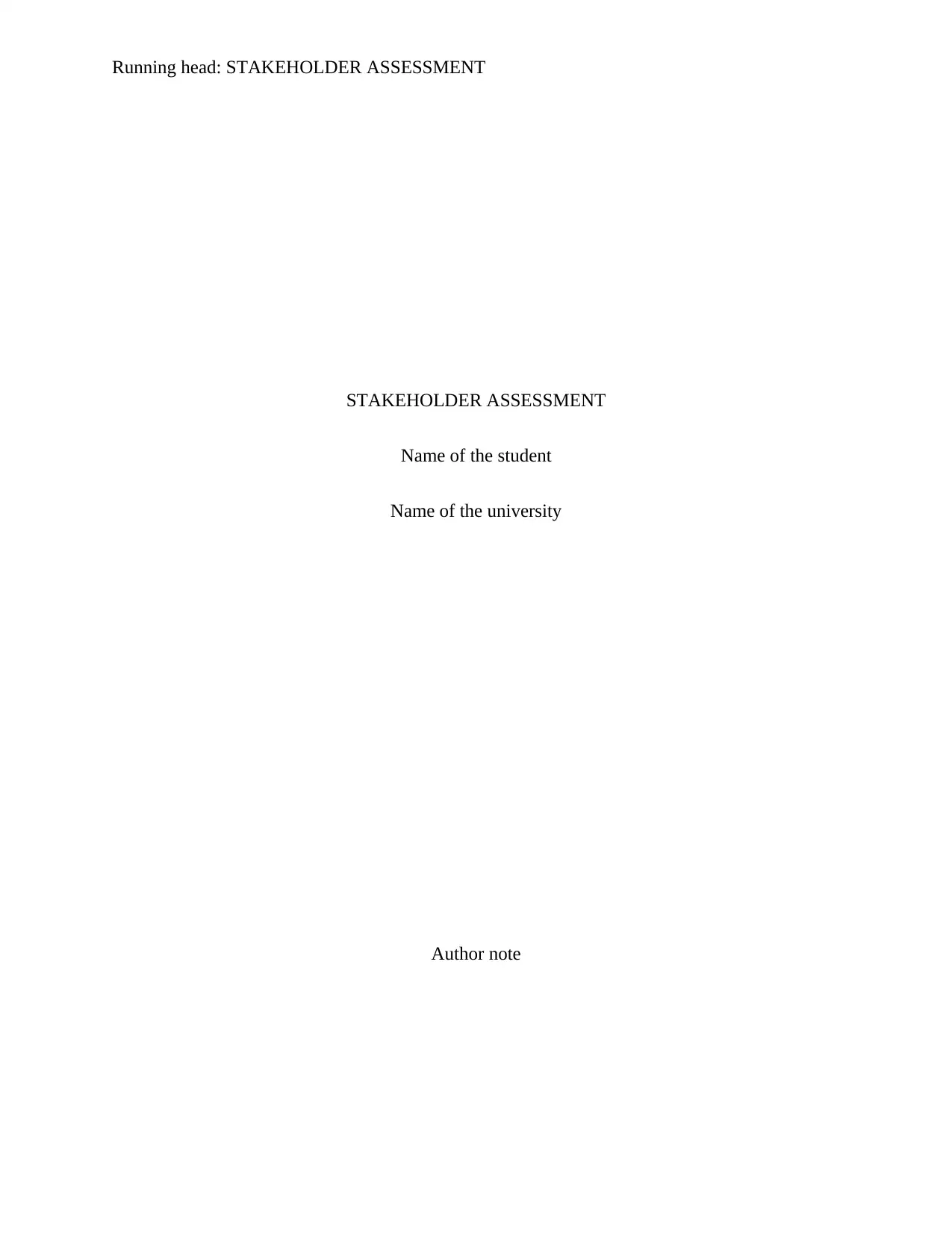
Running head: STAKEHOLDER ASSESSMENT
STAKEHOLDER ASSESSMENT
Name of the student
Name of the university
Author note
STAKEHOLDER ASSESSMENT
Name of the student
Name of the university
Author note
Paraphrase This Document
Need a fresh take? Get an instant paraphrase of this document with our AI Paraphraser
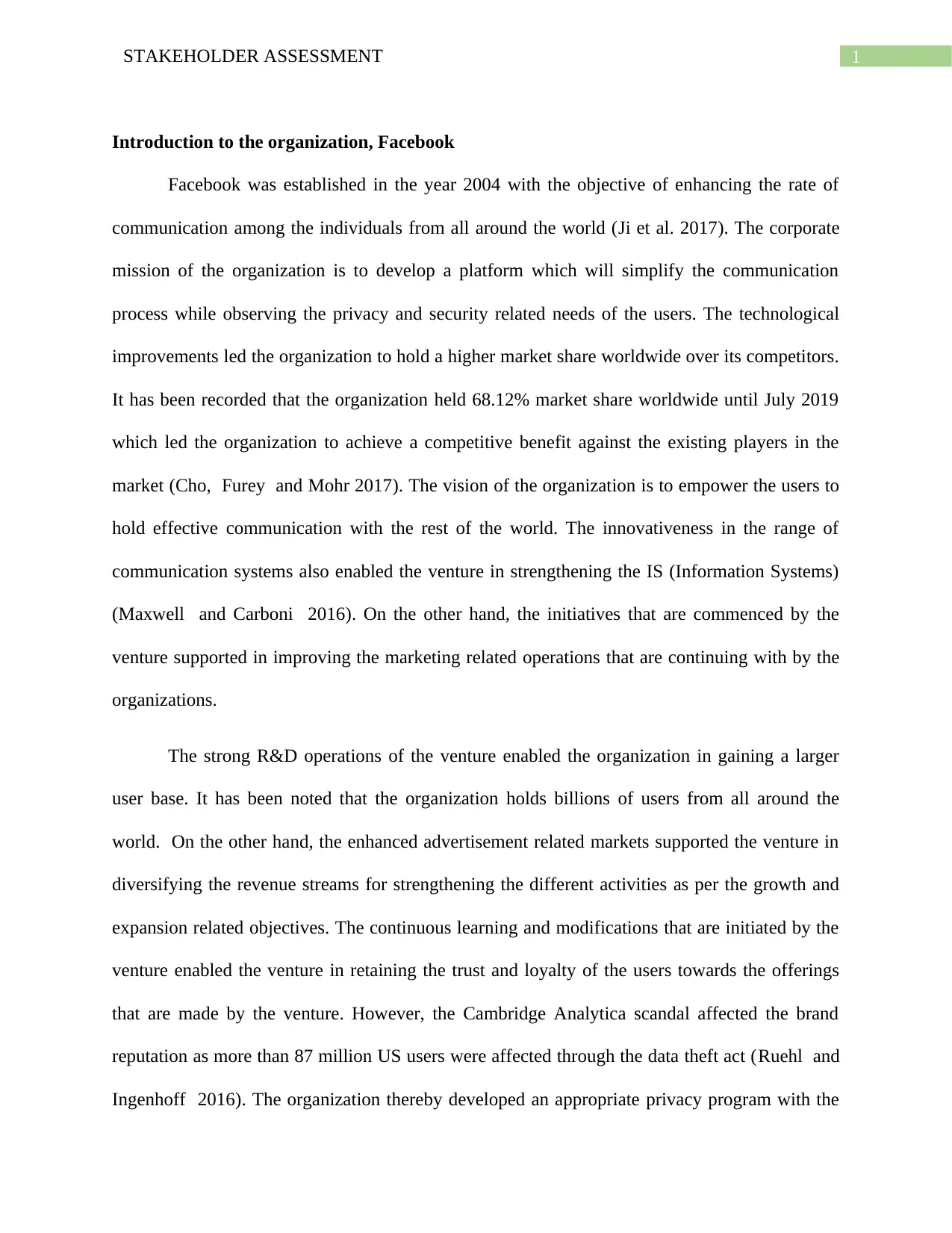
1STAKEHOLDER ASSESSMENT
Introduction to the organization, Facebook
Facebook was established in the year 2004 with the objective of enhancing the rate of
communication among the individuals from all around the world (Ji et al. 2017). The corporate
mission of the organization is to develop a platform which will simplify the communication
process while observing the privacy and security related needs of the users. The technological
improvements led the organization to hold a higher market share worldwide over its competitors.
It has been recorded that the organization held 68.12% market share worldwide until July 2019
which led the organization to achieve a competitive benefit against the existing players in the
market (Cho, Furey and Mohr 2017). The vision of the organization is to empower the users to
hold effective communication with the rest of the world. The innovativeness in the range of
communication systems also enabled the venture in strengthening the IS (Information Systems)
(Maxwell and Carboni 2016). On the other hand, the initiatives that are commenced by the
venture supported in improving the marketing related operations that are continuing with by the
organizations.
The strong R&D operations of the venture enabled the organization in gaining a larger
user base. It has been noted that the organization holds billions of users from all around the
world. On the other hand, the enhanced advertisement related markets supported the venture in
diversifying the revenue streams for strengthening the different activities as per the growth and
expansion related objectives. The continuous learning and modifications that are initiated by the
venture enabled the venture in retaining the trust and loyalty of the users towards the offerings
that are made by the venture. However, the Cambridge Analytica scandal affected the brand
reputation as more than 87 million US users were affected through the data theft act (Ruehl and
Ingenhoff 2016). The organization thereby developed an appropriate privacy program with the
Introduction to the organization, Facebook
Facebook was established in the year 2004 with the objective of enhancing the rate of
communication among the individuals from all around the world (Ji et al. 2017). The corporate
mission of the organization is to develop a platform which will simplify the communication
process while observing the privacy and security related needs of the users. The technological
improvements led the organization to hold a higher market share worldwide over its competitors.
It has been recorded that the organization held 68.12% market share worldwide until July 2019
which led the organization to achieve a competitive benefit against the existing players in the
market (Cho, Furey and Mohr 2017). The vision of the organization is to empower the users to
hold effective communication with the rest of the world. The innovativeness in the range of
communication systems also enabled the venture in strengthening the IS (Information Systems)
(Maxwell and Carboni 2016). On the other hand, the initiatives that are commenced by the
venture supported in improving the marketing related operations that are continuing with by the
organizations.
The strong R&D operations of the venture enabled the organization in gaining a larger
user base. It has been noted that the organization holds billions of users from all around the
world. On the other hand, the enhanced advertisement related markets supported the venture in
diversifying the revenue streams for strengthening the different activities as per the growth and
expansion related objectives. The continuous learning and modifications that are initiated by the
venture enabled the venture in retaining the trust and loyalty of the users towards the offerings
that are made by the venture. However, the Cambridge Analytica scandal affected the brand
reputation as more than 87 million US users were affected through the data theft act (Ruehl and
Ingenhoff 2016). The organization thereby developed an appropriate privacy program with the
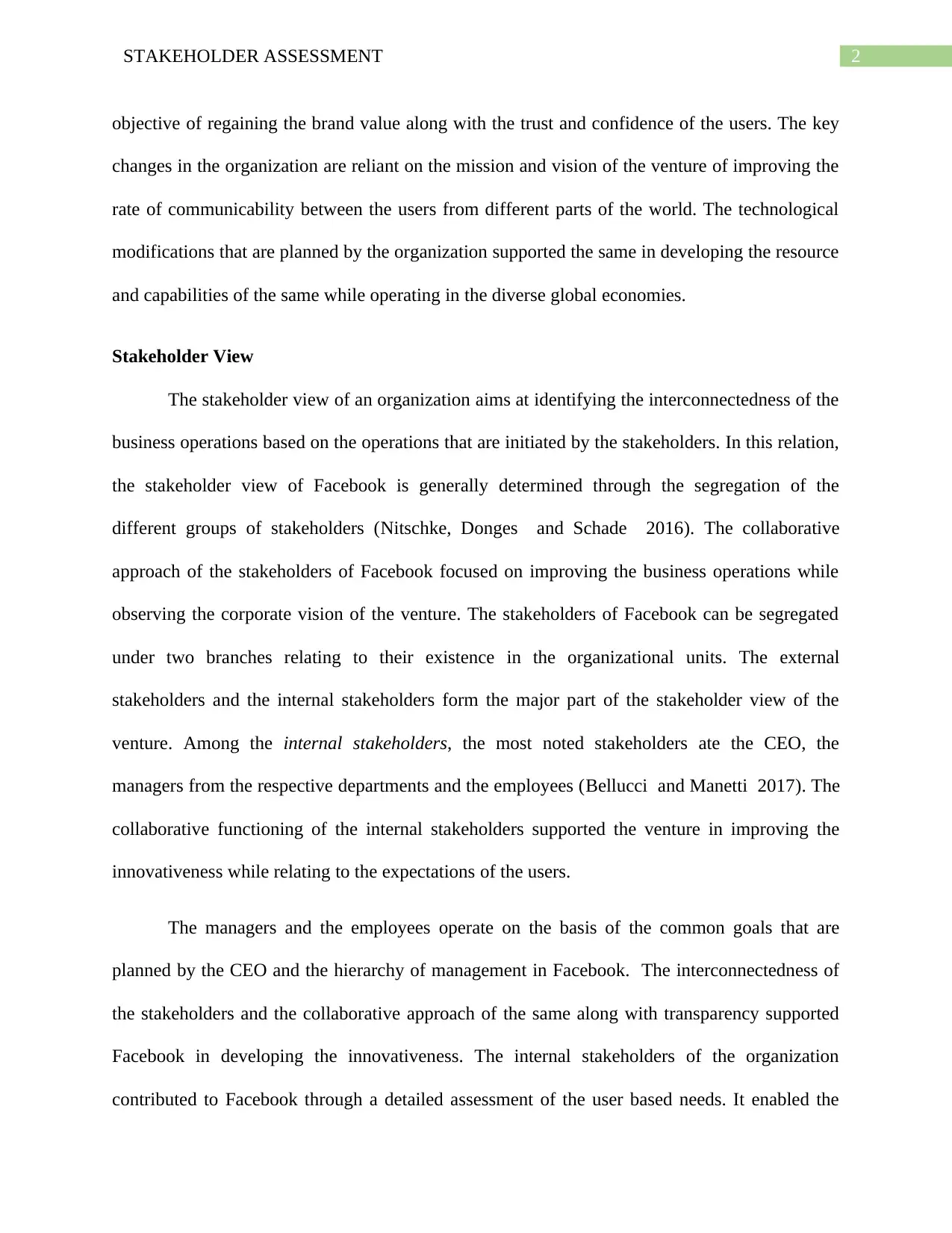
2STAKEHOLDER ASSESSMENT
objective of regaining the brand value along with the trust and confidence of the users. The key
changes in the organization are reliant on the mission and vision of the venture of improving the
rate of communicability between the users from different parts of the world. The technological
modifications that are planned by the organization supported the same in developing the resource
and capabilities of the same while operating in the diverse global economies.
Stakeholder View
The stakeholder view of an organization aims at identifying the interconnectedness of the
business operations based on the operations that are initiated by the stakeholders. In this relation,
the stakeholder view of Facebook is generally determined through the segregation of the
different groups of stakeholders (Nitschke, Donges and Schade 2016). The collaborative
approach of the stakeholders of Facebook focused on improving the business operations while
observing the corporate vision of the venture. The stakeholders of Facebook can be segregated
under two branches relating to their existence in the organizational units. The external
stakeholders and the internal stakeholders form the major part of the stakeholder view of the
venture. Among the internal stakeholders, the most noted stakeholders ate the CEO, the
managers from the respective departments and the employees (Bellucci and Manetti 2017). The
collaborative functioning of the internal stakeholders supported the venture in improving the
innovativeness while relating to the expectations of the users.
The managers and the employees operate on the basis of the common goals that are
planned by the CEO and the hierarchy of management in Facebook. The interconnectedness of
the stakeholders and the collaborative approach of the same along with transparency supported
Facebook in developing the innovativeness. The internal stakeholders of the organization
contributed to Facebook through a detailed assessment of the user based needs. It enabled the
objective of regaining the brand value along with the trust and confidence of the users. The key
changes in the organization are reliant on the mission and vision of the venture of improving the
rate of communicability between the users from different parts of the world. The technological
modifications that are planned by the organization supported the same in developing the resource
and capabilities of the same while operating in the diverse global economies.
Stakeholder View
The stakeholder view of an organization aims at identifying the interconnectedness of the
business operations based on the operations that are initiated by the stakeholders. In this relation,
the stakeholder view of Facebook is generally determined through the segregation of the
different groups of stakeholders (Nitschke, Donges and Schade 2016). The collaborative
approach of the stakeholders of Facebook focused on improving the business operations while
observing the corporate vision of the venture. The stakeholders of Facebook can be segregated
under two branches relating to their existence in the organizational units. The external
stakeholders and the internal stakeholders form the major part of the stakeholder view of the
venture. Among the internal stakeholders, the most noted stakeholders ate the CEO, the
managers from the respective departments and the employees (Bellucci and Manetti 2017). The
collaborative functioning of the internal stakeholders supported the venture in improving the
innovativeness while relating to the expectations of the users.
The managers and the employees operate on the basis of the common goals that are
planned by the CEO and the hierarchy of management in Facebook. The interconnectedness of
the stakeholders and the collaborative approach of the same along with transparency supported
Facebook in developing the innovativeness. The internal stakeholders of the organization
contributed to Facebook through a detailed assessment of the user based needs. It enabled the
⊘ This is a preview!⊘
Do you want full access?
Subscribe today to unlock all pages.

Trusted by 1+ million students worldwide
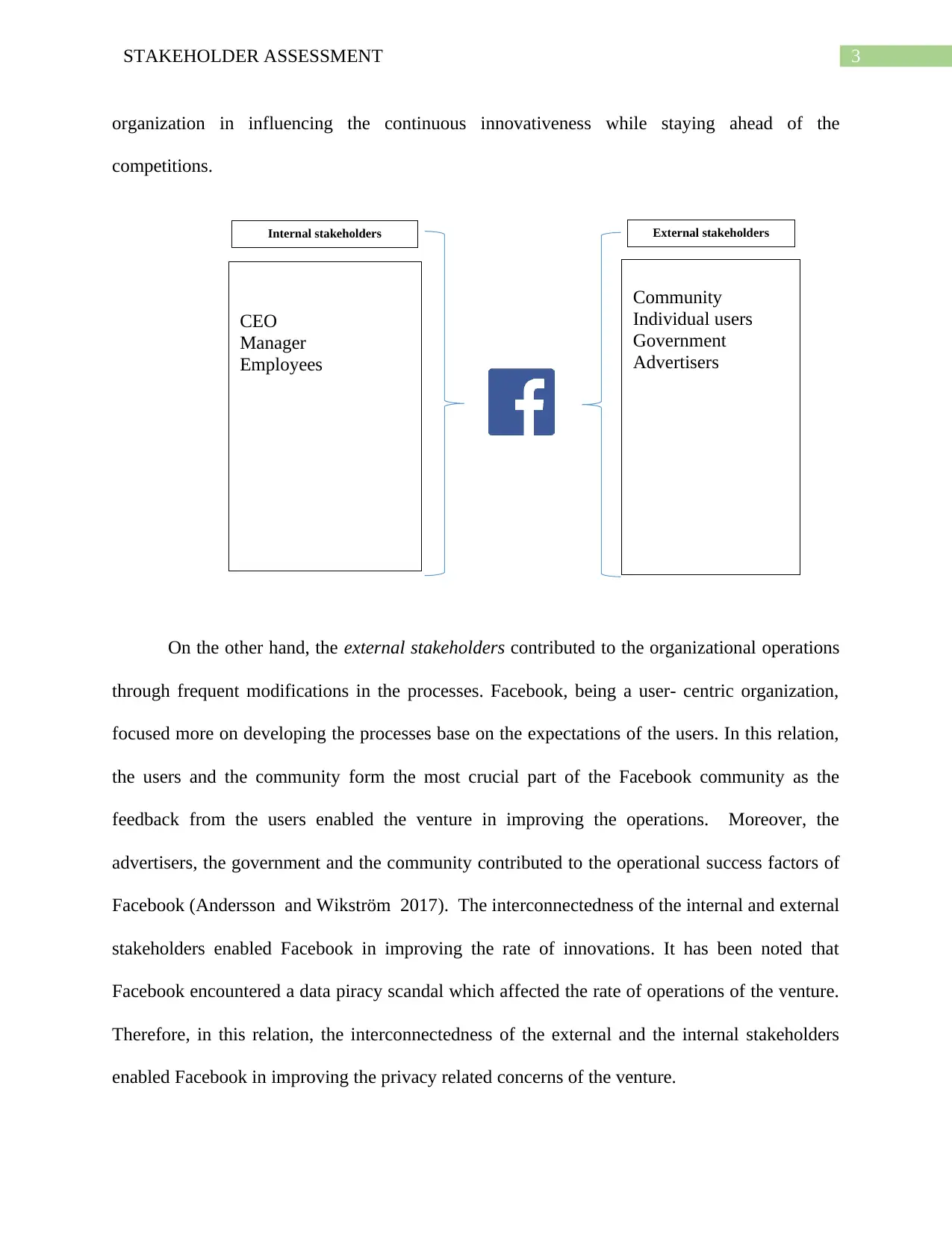
3STAKEHOLDER ASSESSMENT
External stakeholdersInternal stakeholders
CEO
Manager
Employees
Community
Individual users
Government
Advertisers
organization in influencing the continuous innovativeness while staying ahead of the
competitions.
On the other hand, the external stakeholders contributed to the organizational operations
through frequent modifications in the processes. Facebook, being a user- centric organization,
focused more on developing the processes base on the expectations of the users. In this relation,
the users and the community form the most crucial part of the Facebook community as the
feedback from the users enabled the venture in improving the operations. Moreover, the
advertisers, the government and the community contributed to the operational success factors of
Facebook (Andersson and Wikström 2017). The interconnectedness of the internal and external
stakeholders enabled Facebook in improving the rate of innovations. It has been noted that
Facebook encountered a data piracy scandal which affected the rate of operations of the venture.
Therefore, in this relation, the interconnectedness of the external and the internal stakeholders
enabled Facebook in improving the privacy related concerns of the venture.
External stakeholdersInternal stakeholders
CEO
Manager
Employees
Community
Individual users
Government
Advertisers
organization in influencing the continuous innovativeness while staying ahead of the
competitions.
On the other hand, the external stakeholders contributed to the organizational operations
through frequent modifications in the processes. Facebook, being a user- centric organization,
focused more on developing the processes base on the expectations of the users. In this relation,
the users and the community form the most crucial part of the Facebook community as the
feedback from the users enabled the venture in improving the operations. Moreover, the
advertisers, the government and the community contributed to the operational success factors of
Facebook (Andersson and Wikström 2017). The interconnectedness of the internal and external
stakeholders enabled Facebook in improving the rate of innovations. It has been noted that
Facebook encountered a data piracy scandal which affected the rate of operations of the venture.
Therefore, in this relation, the interconnectedness of the external and the internal stakeholders
enabled Facebook in improving the privacy related concerns of the venture.
Paraphrase This Document
Need a fresh take? Get an instant paraphrase of this document with our AI Paraphraser
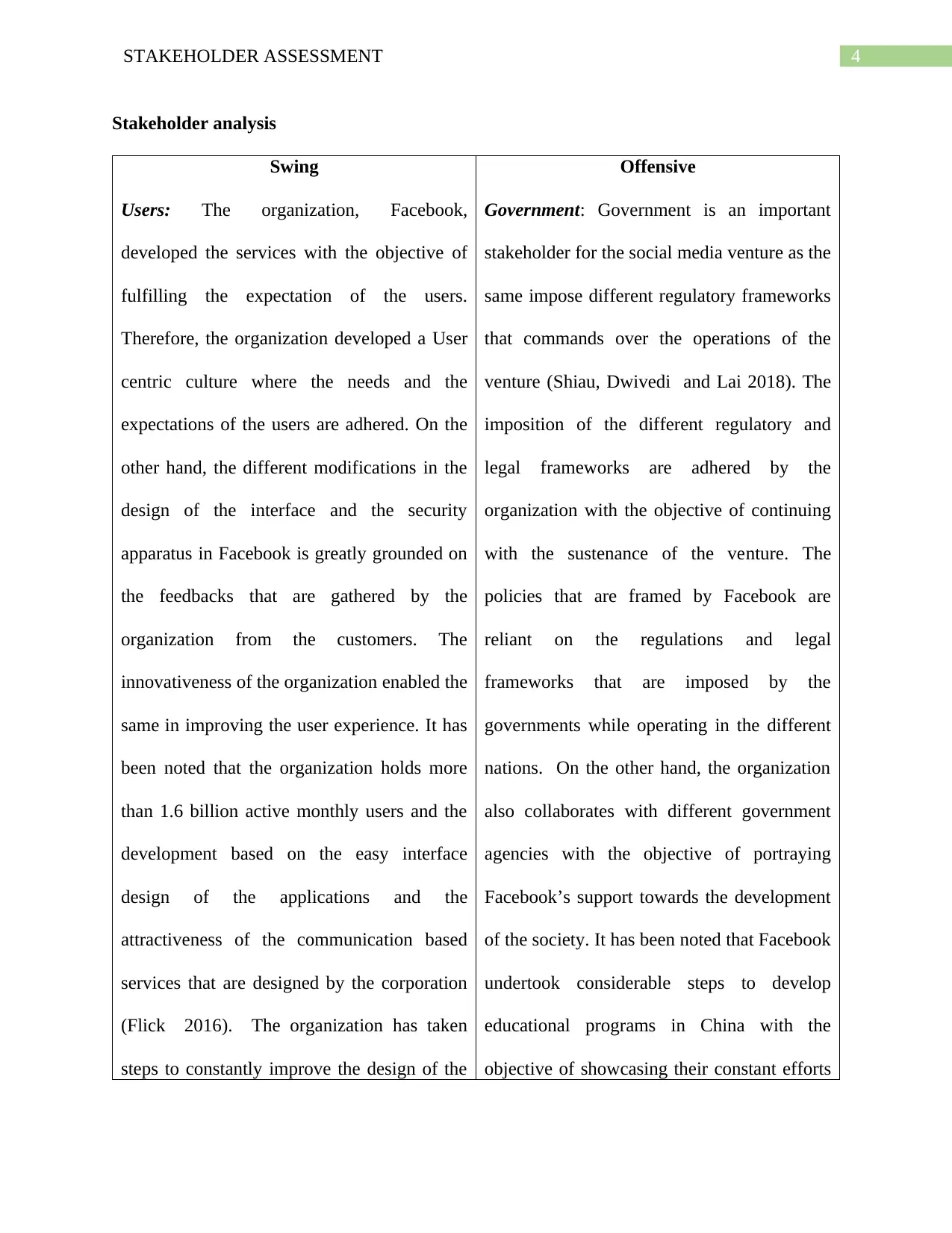
4STAKEHOLDER ASSESSMENT
Stakeholder analysis
Swing
Users: The organization, Facebook,
developed the services with the objective of
fulfilling the expectation of the users.
Therefore, the organization developed a User
centric culture where the needs and the
expectations of the users are adhered. On the
other hand, the different modifications in the
design of the interface and the security
apparatus in Facebook is greatly grounded on
the feedbacks that are gathered by the
organization from the customers. The
innovativeness of the organization enabled the
same in improving the user experience. It has
been noted that the organization holds more
than 1.6 billion active monthly users and the
development based on the easy interface
design of the applications and the
attractiveness of the communication based
services that are designed by the corporation
(Flick 2016). The organization has taken
steps to constantly improve the design of the
Offensive
Government: Government is an important
stakeholder for the social media venture as the
same impose different regulatory frameworks
that commands over the operations of the
venture (Shiau, Dwivedi and Lai 2018). The
imposition of the different regulatory and
legal frameworks are adhered by the
organization with the objective of continuing
with the sustenance of the venture. The
policies that are framed by Facebook are
reliant on the regulations and legal
frameworks that are imposed by the
governments while operating in the different
nations. On the other hand, the organization
also collaborates with different government
agencies with the objective of portraying
Facebook’s support towards the development
of the society. It has been noted that Facebook
undertook considerable steps to develop
educational programs in China with the
objective of showcasing their constant efforts
Stakeholder analysis
Swing
Users: The organization, Facebook,
developed the services with the objective of
fulfilling the expectation of the users.
Therefore, the organization developed a User
centric culture where the needs and the
expectations of the users are adhered. On the
other hand, the different modifications in the
design of the interface and the security
apparatus in Facebook is greatly grounded on
the feedbacks that are gathered by the
organization from the customers. The
innovativeness of the organization enabled the
same in improving the user experience. It has
been noted that the organization holds more
than 1.6 billion active monthly users and the
development based on the easy interface
design of the applications and the
attractiveness of the communication based
services that are designed by the corporation
(Flick 2016). The organization has taken
steps to constantly improve the design of the
Offensive
Government: Government is an important
stakeholder for the social media venture as the
same impose different regulatory frameworks
that commands over the operations of the
venture (Shiau, Dwivedi and Lai 2018). The
imposition of the different regulatory and
legal frameworks are adhered by the
organization with the objective of continuing
with the sustenance of the venture. The
policies that are framed by Facebook are
reliant on the regulations and legal
frameworks that are imposed by the
governments while operating in the different
nations. On the other hand, the organization
also collaborates with different government
agencies with the objective of portraying
Facebook’s support towards the development
of the society. It has been noted that Facebook
undertook considerable steps to develop
educational programs in China with the
objective of showcasing their constant efforts
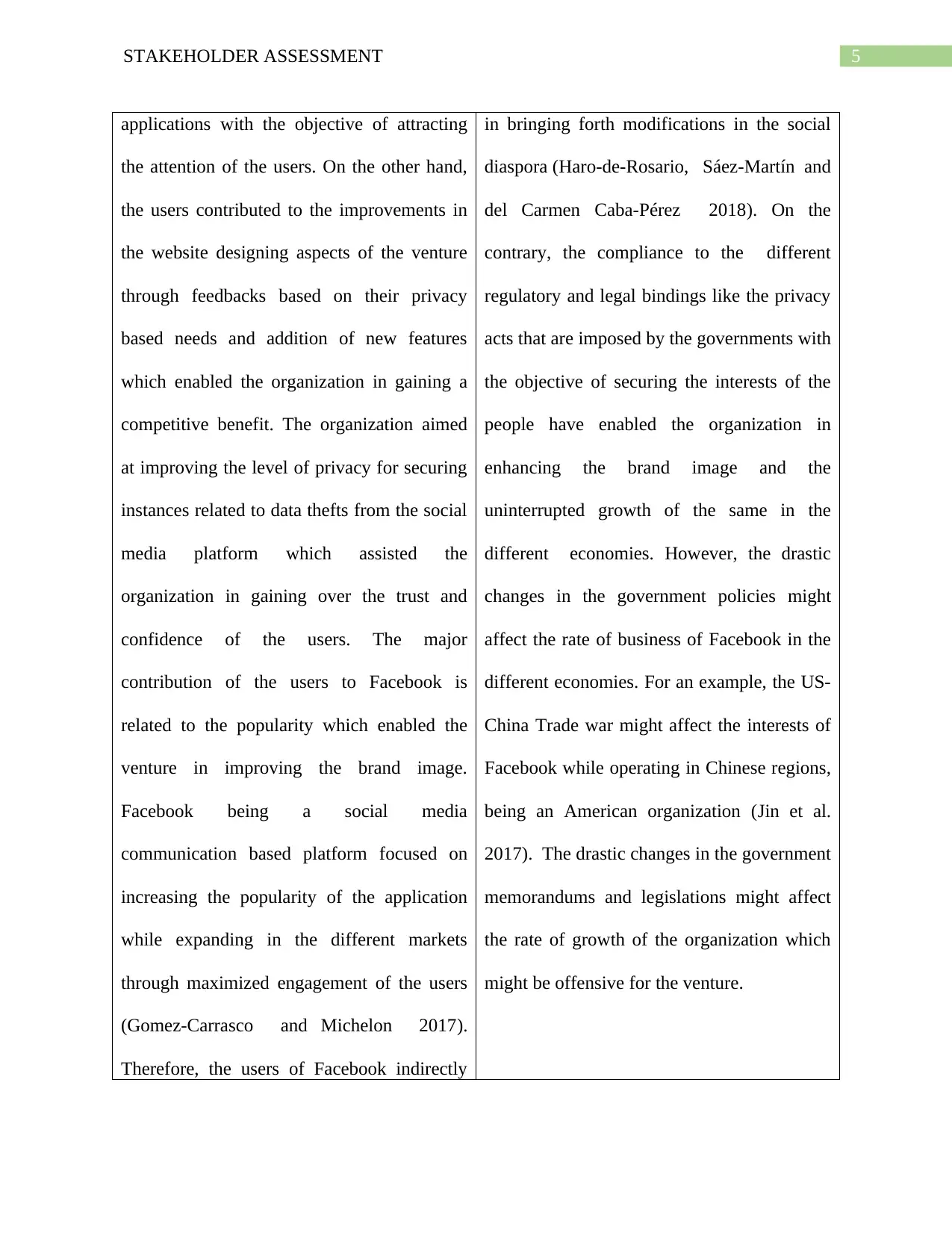
5STAKEHOLDER ASSESSMENT
applications with the objective of attracting
the attention of the users. On the other hand,
the users contributed to the improvements in
the website designing aspects of the venture
through feedbacks based on their privacy
based needs and addition of new features
which enabled the organization in gaining a
competitive benefit. The organization aimed
at improving the level of privacy for securing
instances related to data thefts from the social
media platform which assisted the
organization in gaining over the trust and
confidence of the users. The major
contribution of the users to Facebook is
related to the popularity which enabled the
venture in improving the brand image.
Facebook being a social media
communication based platform focused on
increasing the popularity of the application
while expanding in the different markets
through maximized engagement of the users
(Gomez‐Carrasco and Michelon 2017).
Therefore, the users of Facebook indirectly
in bringing forth modifications in the social
diaspora (Haro-de-Rosario, Sáez-Martín and
del Carmen Caba-Pérez 2018). On the
contrary, the compliance to the different
regulatory and legal bindings like the privacy
acts that are imposed by the governments with
the objective of securing the interests of the
people have enabled the organization in
enhancing the brand image and the
uninterrupted growth of the same in the
different economies. However, the drastic
changes in the government policies might
affect the rate of business of Facebook in the
different economies. For an example, the US-
China Trade war might affect the interests of
Facebook while operating in Chinese regions,
being an American organization (Jin et al.
2017). The drastic changes in the government
memorandums and legislations might affect
the rate of growth of the organization which
might be offensive for the venture.
applications with the objective of attracting
the attention of the users. On the other hand,
the users contributed to the improvements in
the website designing aspects of the venture
through feedbacks based on their privacy
based needs and addition of new features
which enabled the organization in gaining a
competitive benefit. The organization aimed
at improving the level of privacy for securing
instances related to data thefts from the social
media platform which assisted the
organization in gaining over the trust and
confidence of the users. The major
contribution of the users to Facebook is
related to the popularity which enabled the
venture in improving the brand image.
Facebook being a social media
communication based platform focused on
increasing the popularity of the application
while expanding in the different markets
through maximized engagement of the users
(Gomez‐Carrasco and Michelon 2017).
Therefore, the users of Facebook indirectly
in bringing forth modifications in the social
diaspora (Haro-de-Rosario, Sáez-Martín and
del Carmen Caba-Pérez 2018). On the
contrary, the compliance to the different
regulatory and legal bindings like the privacy
acts that are imposed by the governments with
the objective of securing the interests of the
people have enabled the organization in
enhancing the brand image and the
uninterrupted growth of the same in the
different economies. However, the drastic
changes in the government policies might
affect the rate of business of Facebook in the
different economies. For an example, the US-
China Trade war might affect the interests of
Facebook while operating in Chinese regions,
being an American organization (Jin et al.
2017). The drastic changes in the government
memorandums and legislations might affect
the rate of growth of the organization which
might be offensive for the venture.
⊘ This is a preview!⊘
Do you want full access?
Subscribe today to unlock all pages.

Trusted by 1+ million students worldwide
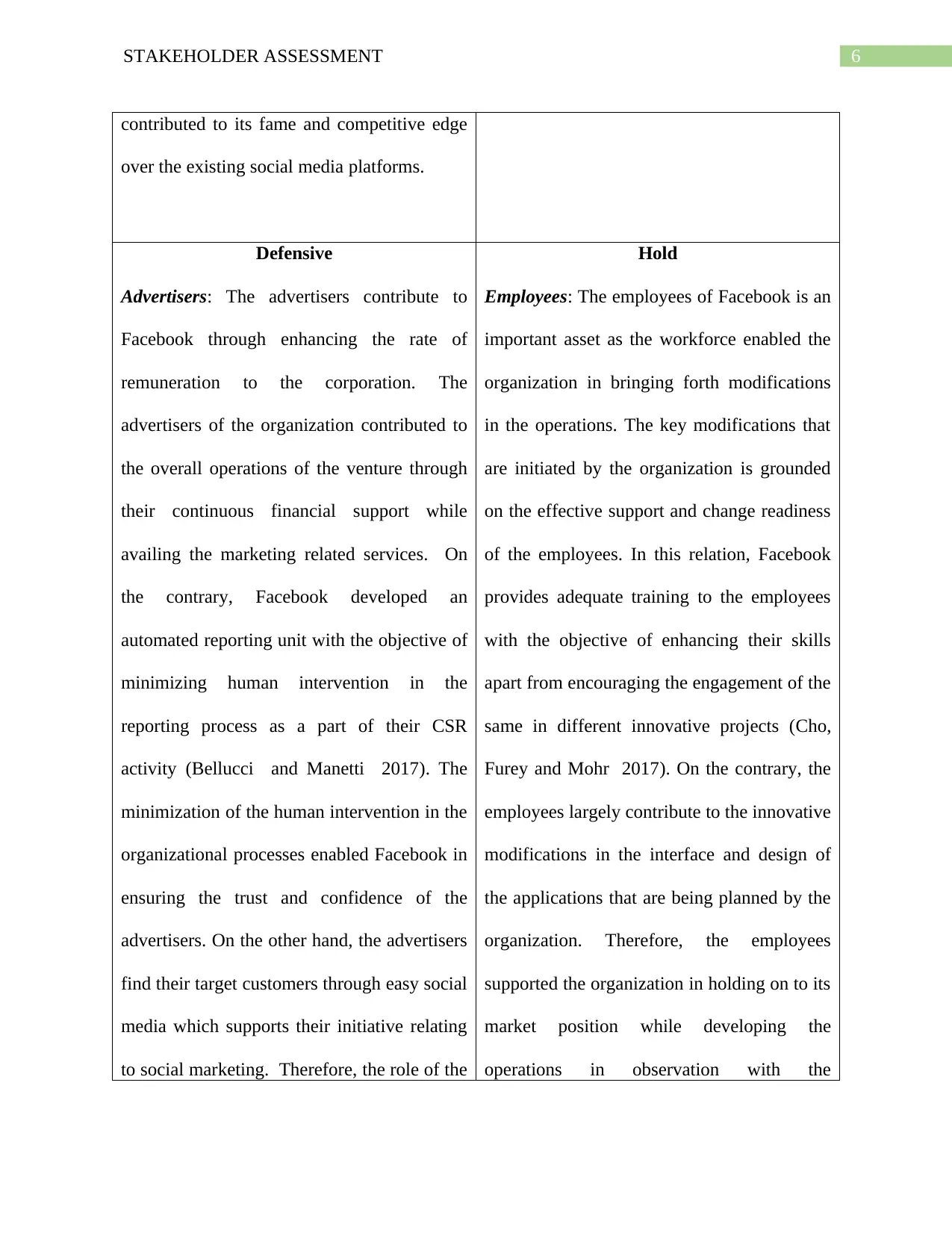
6STAKEHOLDER ASSESSMENT
contributed to its fame and competitive edge
over the existing social media platforms.
Defensive
Advertisers: The advertisers contribute to
Facebook through enhancing the rate of
remuneration to the corporation. The
advertisers of the organization contributed to
the overall operations of the venture through
their continuous financial support while
availing the marketing related services. On
the contrary, Facebook developed an
automated reporting unit with the objective of
minimizing human intervention in the
reporting process as a part of their CSR
activity (Bellucci and Manetti 2017). The
minimization of the human intervention in the
organizational processes enabled Facebook in
ensuring the trust and confidence of the
advertisers. On the other hand, the advertisers
find their target customers through easy social
media which supports their initiative relating
to social marketing. Therefore, the role of the
Hold
Employees: The employees of Facebook is an
important asset as the workforce enabled the
organization in bringing forth modifications
in the operations. The key modifications that
are initiated by the organization is grounded
on the effective support and change readiness
of the employees. In this relation, Facebook
provides adequate training to the employees
with the objective of enhancing their skills
apart from encouraging the engagement of the
same in different innovative projects (Cho,
Furey and Mohr 2017). On the contrary, the
employees largely contribute to the innovative
modifications in the interface and design of
the applications that are being planned by the
organization. Therefore, the employees
supported the organization in holding on to its
market position while developing the
operations in observation with the
contributed to its fame and competitive edge
over the existing social media platforms.
Defensive
Advertisers: The advertisers contribute to
Facebook through enhancing the rate of
remuneration to the corporation. The
advertisers of the organization contributed to
the overall operations of the venture through
their continuous financial support while
availing the marketing related services. On
the contrary, Facebook developed an
automated reporting unit with the objective of
minimizing human intervention in the
reporting process as a part of their CSR
activity (Bellucci and Manetti 2017). The
minimization of the human intervention in the
organizational processes enabled Facebook in
ensuring the trust and confidence of the
advertisers. On the other hand, the advertisers
find their target customers through easy social
media which supports their initiative relating
to social marketing. Therefore, the role of the
Hold
Employees: The employees of Facebook is an
important asset as the workforce enabled the
organization in bringing forth modifications
in the operations. The key modifications that
are initiated by the organization is grounded
on the effective support and change readiness
of the employees. In this relation, Facebook
provides adequate training to the employees
with the objective of enhancing their skills
apart from encouraging the engagement of the
same in different innovative projects (Cho,
Furey and Mohr 2017). On the contrary, the
employees largely contribute to the innovative
modifications in the interface and design of
the applications that are being planned by the
organization. Therefore, the employees
supported the organization in holding on to its
market position while developing the
operations in observation with the
Paraphrase This Document
Need a fresh take? Get an instant paraphrase of this document with our AI Paraphraser
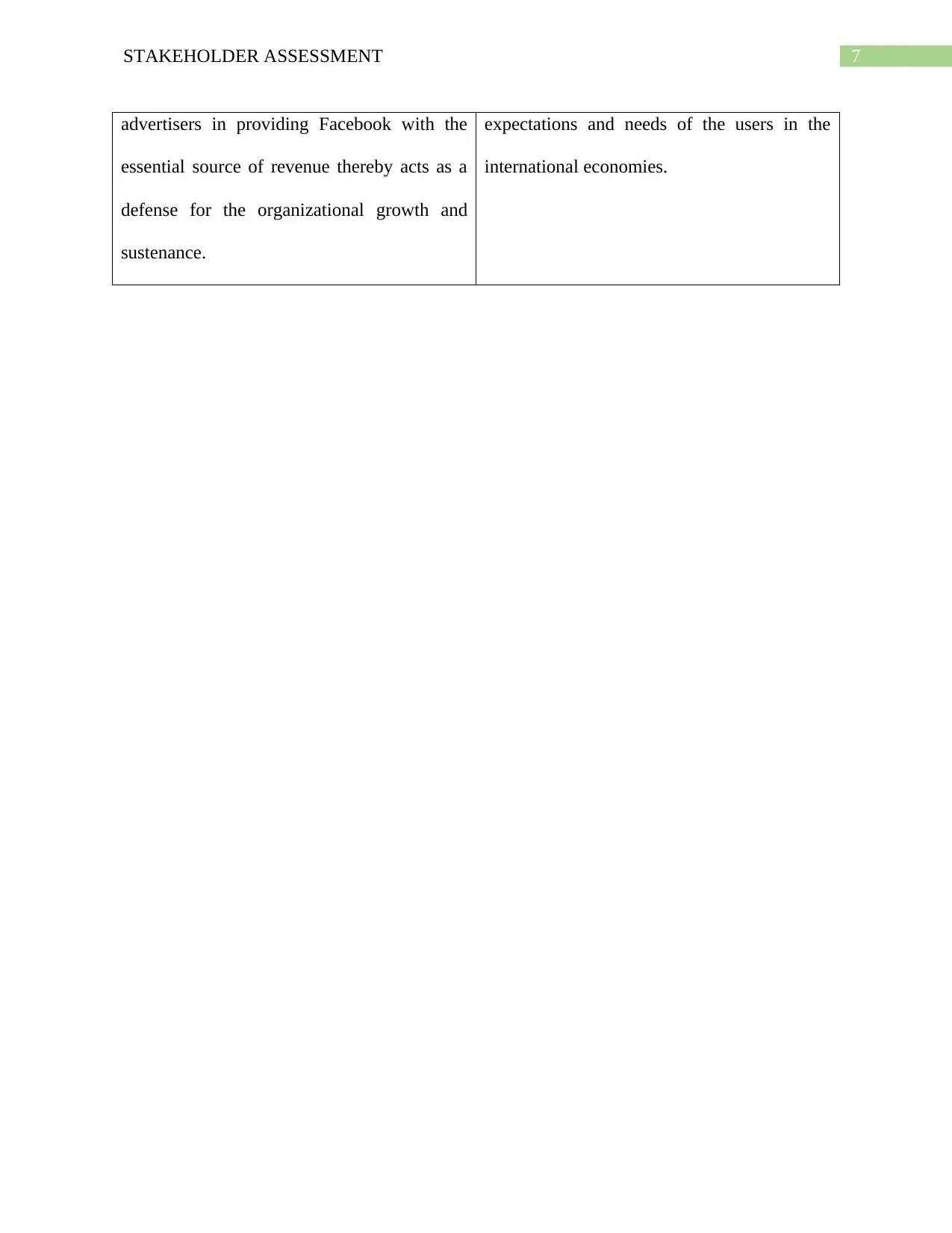
7STAKEHOLDER ASSESSMENT
advertisers in providing Facebook with the
essential source of revenue thereby acts as a
defense for the organizational growth and
sustenance.
expectations and needs of the users in the
international economies.
advertisers in providing Facebook with the
essential source of revenue thereby acts as a
defense for the organizational growth and
sustenance.
expectations and needs of the users in the
international economies.
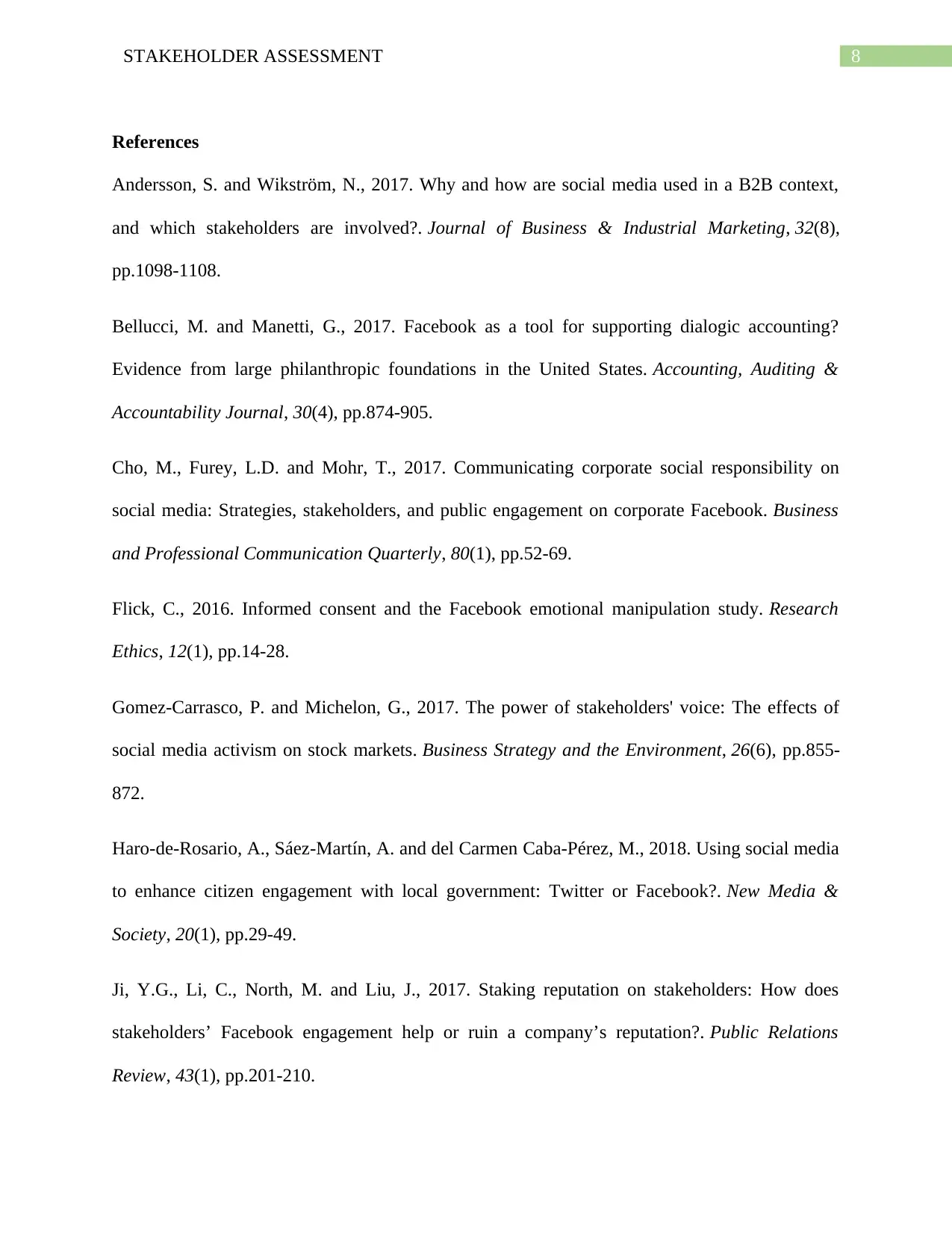
8STAKEHOLDER ASSESSMENT
References
Andersson, S. and Wikström, N., 2017. Why and how are social media used in a B2B context,
and which stakeholders are involved?. Journal of Business & Industrial Marketing, 32(8),
pp.1098-1108.
Bellucci, M. and Manetti, G., 2017. Facebook as a tool for supporting dialogic accounting?
Evidence from large philanthropic foundations in the United States. Accounting, Auditing &
Accountability Journal, 30(4), pp.874-905.
Cho, M., Furey, L.D. and Mohr, T., 2017. Communicating corporate social responsibility on
social media: Strategies, stakeholders, and public engagement on corporate Facebook. Business
and Professional Communication Quarterly, 80(1), pp.52-69.
Flick, C., 2016. Informed consent and the Facebook emotional manipulation study. Research
Ethics, 12(1), pp.14-28.
Gomez‐Carrasco, P. and Michelon, G., 2017. The power of stakeholders' voice: The effects of
social media activism on stock markets. Business Strategy and the Environment, 26(6), pp.855-
872.
Haro-de-Rosario, A., Sáez-Martín, A. and del Carmen Caba-Pérez, M., 2018. Using social media
to enhance citizen engagement with local government: Twitter or Facebook?. New Media &
Society, 20(1), pp.29-49.
Ji, Y.G., Li, C., North, M. and Liu, J., 2017. Staking reputation on stakeholders: How does
stakeholders’ Facebook engagement help or ruin a company’s reputation?. Public Relations
Review, 43(1), pp.201-210.
References
Andersson, S. and Wikström, N., 2017. Why and how are social media used in a B2B context,
and which stakeholders are involved?. Journal of Business & Industrial Marketing, 32(8),
pp.1098-1108.
Bellucci, M. and Manetti, G., 2017. Facebook as a tool for supporting dialogic accounting?
Evidence from large philanthropic foundations in the United States. Accounting, Auditing &
Accountability Journal, 30(4), pp.874-905.
Cho, M., Furey, L.D. and Mohr, T., 2017. Communicating corporate social responsibility on
social media: Strategies, stakeholders, and public engagement on corporate Facebook. Business
and Professional Communication Quarterly, 80(1), pp.52-69.
Flick, C., 2016. Informed consent and the Facebook emotional manipulation study. Research
Ethics, 12(1), pp.14-28.
Gomez‐Carrasco, P. and Michelon, G., 2017. The power of stakeholders' voice: The effects of
social media activism on stock markets. Business Strategy and the Environment, 26(6), pp.855-
872.
Haro-de-Rosario, A., Sáez-Martín, A. and del Carmen Caba-Pérez, M., 2018. Using social media
to enhance citizen engagement with local government: Twitter or Facebook?. New Media &
Society, 20(1), pp.29-49.
Ji, Y.G., Li, C., North, M. and Liu, J., 2017. Staking reputation on stakeholders: How does
stakeholders’ Facebook engagement help or ruin a company’s reputation?. Public Relations
Review, 43(1), pp.201-210.
⊘ This is a preview!⊘
Do you want full access?
Subscribe today to unlock all pages.

Trusted by 1+ million students worldwide
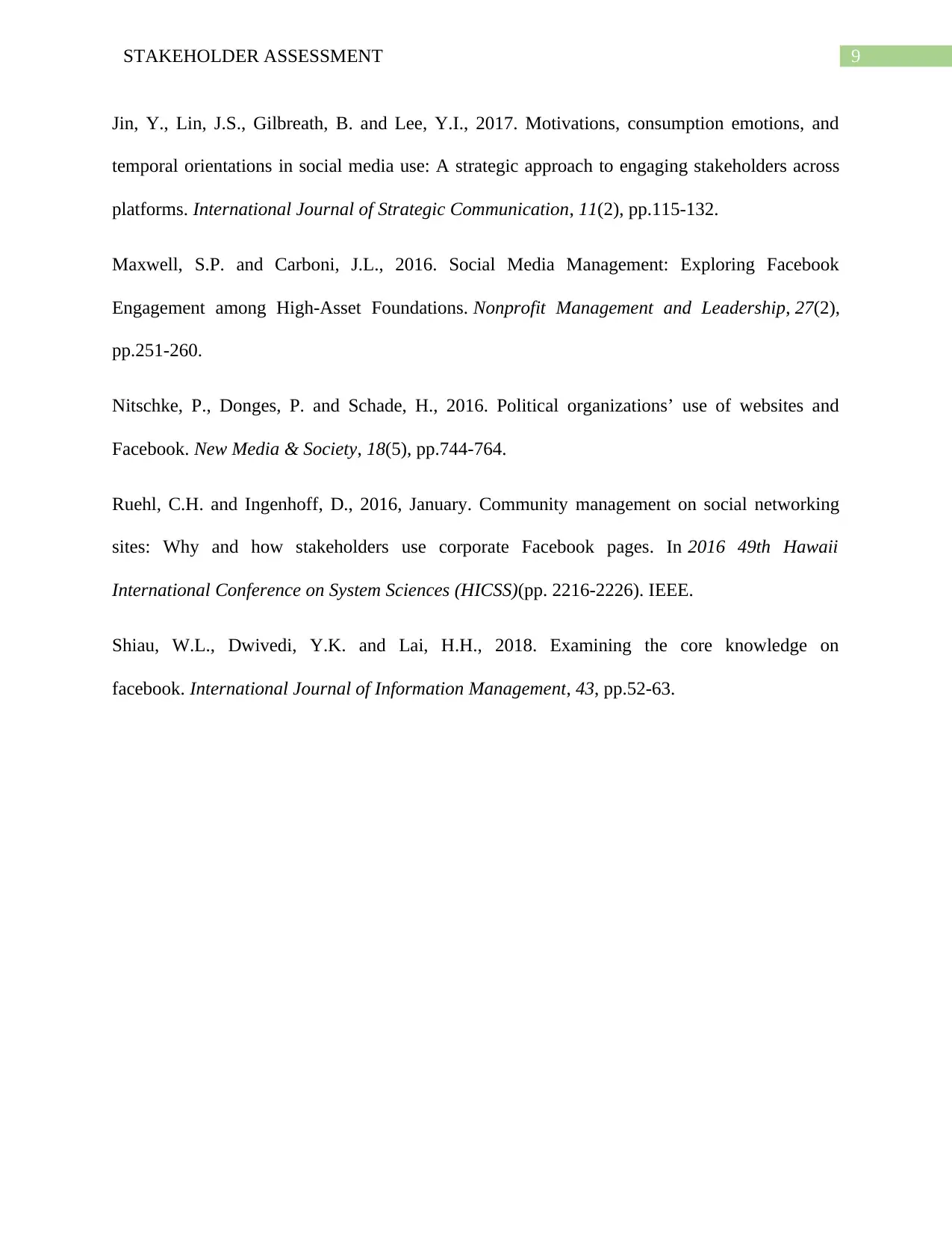
9STAKEHOLDER ASSESSMENT
Jin, Y., Lin, J.S., Gilbreath, B. and Lee, Y.I., 2017. Motivations, consumption emotions, and
temporal orientations in social media use: A strategic approach to engaging stakeholders across
platforms. International Journal of Strategic Communication, 11(2), pp.115-132.
Maxwell, S.P. and Carboni, J.L., 2016. Social Media Management: Exploring Facebook
Engagement among High‐Asset Foundations. Nonprofit Management and Leadership, 27(2),
pp.251-260.
Nitschke, P., Donges, P. and Schade, H., 2016. Political organizations’ use of websites and
Facebook. New Media & Society, 18(5), pp.744-764.
Ruehl, C.H. and Ingenhoff, D., 2016, January. Community management on social networking
sites: Why and how stakeholders use corporate Facebook pages. In 2016 49th Hawaii
International Conference on System Sciences (HICSS)(pp. 2216-2226). IEEE.
Shiau, W.L., Dwivedi, Y.K. and Lai, H.H., 2018. Examining the core knowledge on
facebook. International Journal of Information Management, 43, pp.52-63.
Jin, Y., Lin, J.S., Gilbreath, B. and Lee, Y.I., 2017. Motivations, consumption emotions, and
temporal orientations in social media use: A strategic approach to engaging stakeholders across
platforms. International Journal of Strategic Communication, 11(2), pp.115-132.
Maxwell, S.P. and Carboni, J.L., 2016. Social Media Management: Exploring Facebook
Engagement among High‐Asset Foundations. Nonprofit Management and Leadership, 27(2),
pp.251-260.
Nitschke, P., Donges, P. and Schade, H., 2016. Political organizations’ use of websites and
Facebook. New Media & Society, 18(5), pp.744-764.
Ruehl, C.H. and Ingenhoff, D., 2016, January. Community management on social networking
sites: Why and how stakeholders use corporate Facebook pages. In 2016 49th Hawaii
International Conference on System Sciences (HICSS)(pp. 2216-2226). IEEE.
Shiau, W.L., Dwivedi, Y.K. and Lai, H.H., 2018. Examining the core knowledge on
facebook. International Journal of Information Management, 43, pp.52-63.
1 out of 10
Related Documents
Your All-in-One AI-Powered Toolkit for Academic Success.
+13062052269
info@desklib.com
Available 24*7 on WhatsApp / Email
![[object Object]](/_next/static/media/star-bottom.7253800d.svg)
Unlock your academic potential
Copyright © 2020–2025 A2Z Services. All Rights Reserved. Developed and managed by ZUCOL.





